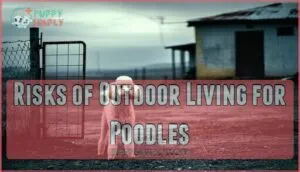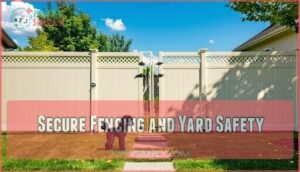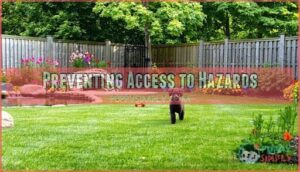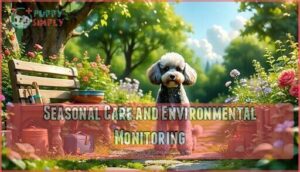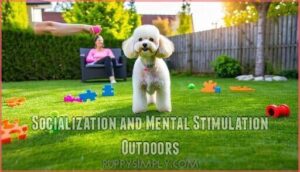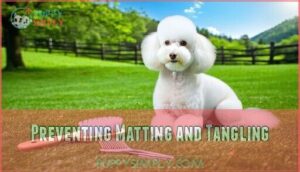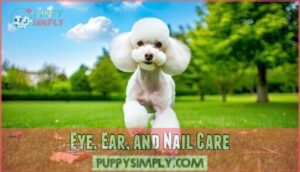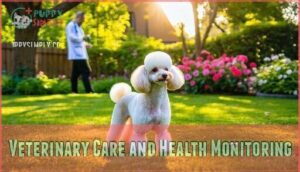This site is supported by our readers. We may earn a commission, at no cost to you, if you purchase through links.

These social butterflies crave human interaction, so extended outdoor isolation often triggers behavioral issues. Think of poodles as indoor dogs who love outdoor adventures, not outdoor dogs who tolerate indoor visits. Their hypoallergenic qualities shine indoors where they stay cleaner and happier.
Smart shelter solutions and seasonal adjustments can help outdoor-loving poodle parents find the right balance.
Table Of Contents
- Key Takeaways
- Can Poodles Live Outside?
- Poodle Breed Traits and Sensitivities
- Risks of Outdoor Living for Poodles
- Essential Outdoor Shelter and Safety Tips
- Seasonal Care and Environmental Monitoring
- Socialization and Mental Stimulation Outdoors
- Grooming and Hygiene for Outdoor Poodles
- Veterinary Care and Health Monitoring
- Indoor Living Benefits and Alternatives
- Frequently Asked Questions (FAQs)
- What are some ways to keep my poodle entertained if it has to be outside?
- How often should I check on my poodle if it lives primarily outdoors?
- What is the ideal outdoor shelter or housing set-up for a poodle?
- Can poodles get fleas and ticks outdoors?
- Do poodles need special outdoor exercise equipment?
- What plants are toxic to poodles outside?
- How often should outdoor poodles be bathed?
- Can poodles swim in natural water sources?
- Conclusion
Key Takeaways
- You can keep your poodle outside with proper shelter and care, but they’re not built for it—temperatures below 32°F are uncomfortable, and their high-maintenance coats become matted messes without regular grooming.
- Your poodle’s social butterfly nature means extended outdoor isolation triggers behavioral problems like excessive barking and destructive chewing since they crave human interaction over outdoor adventures.
- You’ll face serious health risks, including hypothermia, heat stroke, skin irritation, and anxiety-related behaviors when your poodle lives primarily outdoors instead of enjoying supervised outdoor time.
- You should think of your poodle as an indoor dog who loves outdoor adventures rather than an outdoor dog—their hypoallergenic qualities and mental health thrive best with indoor living and scheduled outdoor play sessions.
Can Poodles Live Outside?
Can your poodle live outside? It depends. These smart dogs can handle outdoor life with the right setup, but they’re not built for it.
Once temperatures drop below freezing, poodles start getting uncomfortable – especially the smaller toy and miniature varieties who feel the cold more.
Keep them outside too long and you’ll see problem behaviors kick in—excessive barking, digging up your yard, chewing anything they can find. As a poodle owner, you need to do way more than just throw up some shelter.
Smaller toy breeds need extra cold protection since they feel temperature changes more than standard poodles. Once it hits 90 degrees or higher, you’re looking at a potentially deadly situation for your dog.
The reality is that poodles thrive on human companionship and mental stimulation. Creating a safe Poodle outdoor lifestyle demands careful attention to their health and wellbeing, making indoor living the preferred choice for most dog care experts. To mitigate these risks, it’s vital to understand heatstroke prevention methods and take necessary precautions.
Poodle Breed Traits and Sensitivities
Your poodle’s unique characteristics make outdoor living challenging, as these intelligent dogs weren’t built for roughing it like their hunting ancestors.
Before you even think about outdoor living, know this: that gorgeous curly coat has limits when temperatures drop, and smaller poodles feel the cold much more than their standard-sized cousins.
Plus, these dogs are people-pleasers at heart—they crave being close to their humans.
Coat Characteristics and Grooming Needs
Your poodle’s unique curly coat requires dedicated maintenance to prevent matting and skin issues. This dense, water-resistant texture traps dirt and debris, making regular grooming essential for outdoor living.
Poodle shedding is minimal, but their coat grows continuously, demanding professional grooming tools and consistent brushing. Without proper coat maintenance, matting occurs rapidly, creating painful tangles that compromise your dog’s comfort and health outdoors.
Temperature Tolerance by Size
Temperature considerations vary dramatically across poodle breeds, making size the key factor in outdoor living decisions. Standard poodles typically handle cold climates down to 32°F, while miniature poodles need extra protection below 45°F. Toy poodles shiver below 45°F and face serious hypothermia risk.
Heat sensitivity affects all sizes, with toy poodles experiencing heat exhaustion above 77°F and standards struggling past 85°F. To guarantee their safety, it’s vital to contemplate cold weather precautions when deciding to keep them outside.
Social and Emotional Needs
Beyond temperature concerns, your poodle craves constant social interaction and emotional assistance. These "velcro dogs" form intense owner attachment and suffer when isolated outdoors.
Canine companionship alone won’t satisfy their mental stimulation needs. Without regular human contact, poodles develop anxiety and destructive behaviors.
Their intelligence demands engaging social bonds for peak Poodle health and wellbeing through proper training and socialization.
Risks of Outdoor Living for Poodles
Thinking about keeping your poodle outside? You’re looking at some real problems that could seriously impact their health and happiness. Poodles are smart, people-focused dogs that simply weren’t designed for outdoor life.
Their curly coats and sensitive skin leave them exposed to harsh weather conditions. Their strong need for human companionship can lead to anxiety and destructive behaviors when left alone outside.
Health Threats From Extreme Weather
Weather extremes can seriously harm your poodle’s health when they’re outside. Hot weather is especially dangerous—heat stroke happens fast and can kill your dog within minutes. Cold weather hits smaller poodles harder than larger breeds.
To keep your poodle safe, you need to understand how they handle different temperatures and what they need to stay comfortable outdoors.
- Heat stroke kills—your poodle’s internal temperature reaches 106°F, causing brain swelling and organ failure
- Hypothermia symptoms include excessive shivering, lethargy, weak pulse, and potential unresponsiveness
- Temperatures below 20°F put all dogs at risk for hypothermia and frostbite during extended outdoor exposure
- Extreme heat causes hyperthermia, dehydration, heatstroke, and permanent organ damage
- Warning signs include uncontrollable shivering, unusual tiredness, difficulty moving, and unwillingness to play
Skin and Coat Issues Outdoors
Outdoor elements wreak havoc on your poodle’s delicate coat and skin. Coat matting becomes inevitable when moisture, debris, and wind tangle those beautiful curls.
Skin irritation develops from outdoor allergies, dirt buildup, and constant weather damage. Sun protection isn’t optional—poodles lack the thick undercoat that shields other breeds.
Without proper poodle coat maintenance and regular grooming requirements, hypoallergenic dogs quickly lose their trademark qualities outdoors.
Anxiety and Behavioral Concerns
Poodles bond deeply with their families, making outdoor isolation particularly stressful. This anxiety can trigger destructive behaviors, excessive barking, and attempts to escape, creating a nightmare for both you and your poodle. Their social needs make outdoor solitude mentally unhealthy.
- Excessive vocalization (barking, whining, howling)
- Destructive behaviors (chewing, digging, property damage)
- Escape attempts (fence climbing, gate rushing)
Essential Outdoor Shelter and Safety Tips
You’ll need to create a proper outdoor shelter that protects your poodle from wind, rain, and temperature extremes, since their curly coats can’t handle harsh weather like other breeds.
Setting up secure fencing and removing yard hazards becomes critical when your poodle spends time outside, as their curious nature and smaller size make them vulnerable to escapes and injuries.
Weatherproof Housing and Warm Bedding
Your outside dog needs proper shelter to stay safe and comfortable. Insulated shelters with waterproof coats protect against harsh weather, while heated kennels provide extra warmth during freezing temperatures.
Choose thermal bedding that wicks moisture away from your poodle’s skin. An igloo dog house offers excellent wind protection, but guarantee adequate ventilation.
Quality indoor shelter features like climate control make all the difference for your poodle’s health.
Secure Fencing and Yard Safety
Before your outside dog can enjoy outdoor living, you’ll need proper fence materials like vinyl or metal panels reaching at least six feet high.
Smart yard layout includes secure gate latches and outdoor lighting for nighttime pet safety.
Mark boundaries clearly so your poodle understands their exercise area limits and stays protected.
Preventing Access to Hazards
Beyond proper fencing, your outside dog needs protection from everyday yard dangers. Regular inspections help spot potential threats before they harm your Poodle.
Your Poodle’s safety depends on smart Hazardous Material Storage choices:
- Remove toxic plants like azaleas, lilies, and oleander from your yard
- Secure all chemicals, fertilizers, and antifreeze in locked containers
- Install Wildlife Deterrents and check Electrical Safety around outdoor outlets
Seasonal Care and Environmental Monitoring
You’ll need to monitor your poodle’s environment year-round since temperature changes can quickly affect their health and comfort levels.
Adjusting their care routine based on seasonal conditions helps prevent weather-related health issues and ensures they stay safe outdoors.
Cold Weather Precautions
Winter’s bite can turn deadly for poodles without proper precautions. You’ll need to monitor temperatures closely and provide adequate protection. Cold weather poses serious risks including hypothermia and frostbite, especially for toy and miniature varieties.
| Temperature Range | Required Protection |
|---|---|
| 45-50°F | Light jacket, limit outdoor time |
| 32-45°F | Insulated coat, booties recommended |
| 20-32°F | Heavy winter gear, short potty breaks |
| Below 20°F | Emergency shelter only, no extended exposure |
| Below 0°F | Indoor confinement mandatory |
Climate adaptation takes time, so gradually introduce your poodle to cooler temperatures for better cold acclimation.
Hot Weather Dangers
When summer temperatures soar, your Poodle faces serious warm weather hazards that can quickly turn dangerous. Heat stroke becomes a real threat since Poodles can’t regulate body temperature as effectively as humans.
- Heat Stroke Prevention – Watch for excessive panting, drooling, and lethargy during hot days
- Sun Protection – Provide shade and limit midday exercise when UV rays peak
- Dehydration Risks – Monitor water intake closely, as outside dogs need constant hydration
Adjusting Food and Water Needs
Temperature changes dramatically affect your Poodle’s dietary needs and hydration management. Outdoor dogs require careful nutrition planning to maintain energy levels and proper water intake throughout seasonal shifts.
| Season | Water Needs | Food Adjustments | Key Considerations |
|---|---|---|---|
| Winter | Increase 10-15% | Higher calories, warm food | Prevent freezing bowls |
| Summer | Increase 25-30% | Lighter portions, cool treats | Shade water stations |
| Spring/Fall | Monitor closely | Gradual transitions | Watch for allergies |
| Year-round | Fresh daily | Quality protein focus | Veterinary advice essential |
Feeding schedules should adapt to weather conditions for ideal dog health in cold weather.
Socialization and Mental Stimulation Outdoors
Your poodle’s sharp mind needs constant engagement, and outdoor time can’t replace the regular human interaction that prevents anxiety and behavioral problems.
You’ll need to schedule frequent socialization sessions and provide puzzle toys or training activities to keep your intelligent companion mentally healthy while spending time outside.
Human Interaction Requirements
Your Poodle craves your company like a best friend needs coffee in the morning. Social bonding and emotional assistance aren’t just nice-to-haves—they’re necessities for your dog’s mental health.
Owner presence provides vital mental stimulation that prevents anxiety and destructive behaviors. Even outdoor Poodles need regular social interaction for proper training needs and behavioral development.
Preventing Loneliness and Boredom
Beyond regular social interaction, you need to tackle loneliness head-on. Dogs left alone too long can develop destructive behaviors and depression. Mental stimulation becomes your best friend here.
- Rotate toys weekly – fresh challenges keep minds sharp
- Hide treats around the yard – turns feeding into treasure hunts
- Install motion-activated toys – provides entertainment when you’re away
- Schedule mid-day visits – breaks up long stretches alone
- Create puzzle feeders – makes meals last longer and engages problem-solving skills
Social interaction needs don’t disappear outdoors. Your poodle craves emotional assistance and companion care just like indoor dogs. Exercise and mental stimulation work together – a bored poodle is often a problematic poodle.
Outdoor Enrichment Activities
Enrichment transforms outdoor time into meaningful adventures for your poodle. You’ll want to rotate activities regularly, keeping their sharp minds engaged while they explore safely.
| Activity Type | Examples |
|---|---|
| Sensory Stimulation | Nature walks through different terrains, sniffing games with hidden treats |
| Physical Exercise | Agility training with homemade obstacles, playing in the snow during winter activities |
| Mental Challenges | Puzzle feeders outdoors, teaching new tricks during outdoor play sessions |
Environmental enrichment doesn’t require expensive equipment. Simple outdoor fun like fetch variations or Poodle puppy care routines work perfectly for dog exercise needs.
Grooming and Hygiene for Outdoor Poodles
When you keep your poodle outdoors, their curly coat becomes a magnet for dirt, debris, and moisture that can quickly lead to painful matting if you don’t stay on top of regular brushing.
You’ll also need to check their eyes daily for tear stains and clean their ears weekly, since outdoor conditions expose them to more allergens and bacteria than indoor living.
Preventing Matting and Tangling
Daily brushing prevents your poodle’s curly coat from becoming a tangled nightmare. Use a slicker brush and metal comb for thorough coat maintenance. Start at the skin, working outward in small sections.
Professional grooming tools make mat removal easier than wrestling with stubborn knots.
Regular detangling tips include brushing before baths and using leave-in conditioners designed for poodle grooming requirements.
Eye, Ear, and Nail Care
Maintaining proper eye, ear, and nail hygiene keeps your outdoor Poodle healthy and comfortable. These areas collect dirt and debris easily outside.
- Clean tear stains daily with gentle, pH-balanced eye wipes
- Check ears weekly for wax buildup, moisture, or unusual odors
- Trim nails every 2-3 weeks to prevent overgrowth and splitting
- Watch for eye discharge or redness indicating possible infections
- Use cotton balls, never Q-tips, for safe ear cleaning methods
Cleaning and Maintaining Outdoor Areas
Regular outdoor sanitation keeps your poodle healthy and your yard fresh. Clean waste immediately using enzyme-based cleaner to eliminate odors and bacteria.
Weekly area disinfection prevents infections, especially for poodles sleeping outside. Check fence maintenance monthly for safety gaps.
Proper waste management and yard cleaning create safer outdoor fun while protecting your dog’s health during cold weather exposure.
Veterinary Care and Health Monitoring
You’ll need to schedule regular vet visits to catch health problems early, especially since outdoor conditions can stress your poodle’s immune system and expose them to parasites, infections, and temperature-related illnesses.
Watch for warning signs like changes in appetite, energy levels, or bathroom habits, as these often signal underlying issues that require immediate attention.
Regular Check-Ups and Vaccinations
Your outdoor poodle needs veterinary checkups every six months to stay healthy. Vaccination schedules protect against deadly diseases, while health exams catch problems early.
Parasite control prevents fleas, ticks, and worms that thrive outdoors.
Don’t skip dental care and nutrition advice – your vet knows what keeps poodles thriving outside year-round.
Recognizing Signs of Illness or Distress
Watch for subtle Pain Signs like limping, excessive panting, or reluctance to move. Distress Signals include loss of appetite, hiding, or unusual vocalizations.
Health Checks should monitor energy levels and bathroom habits.
Contact Veterinary Care immediately if you notice lethargy, vomiting, or difficulty breathing—your poodle can’t tell you when something’s wrong.
Indoor Living Benefits and Alternatives
While poodles can spend time outdoors, they’re naturally suited for indoor living where their hypoallergenic coat stays cleaner and their social needs are better met.
You can create the perfect balance by establishing a routine that includes outdoor play sessions while keeping your poodle’s primary living space indoors, where temperature control and regular human interaction foster their health and happiness.
Hypoallergenic Qualities Indoors
Your poodle’s hypoallergenic coat shines brightest indoors where you control the environment. Indoor air stays cleaner, reducing pet dander circulation that triggers allergies. Here’s why indoor living wins for allergy prevention:
- Controlled ventilation systems filter allergens effectively
- Regular home cleaning removes trapped dander particles
- Grooming schedules stay consistent without weather interference
Indoor spaces let you maintain ideal allergen reduction while meeting your poodle’s social needs.
Balancing Outdoor Play and Indoor Comfort
Your poodle needs both worlds to thrive. Smart playtime management means balancing vigorous outdoor exercise with cozy indoor comfort zones.
Monitor their energy levels and provide climate control when needed. After outdoor adventures, create peaceful transitions back inside.
Regular health checks help you adjust their routine. This approach maximizes physical stimulation while protecting their sensitive nature from harsh elements.
Creating a Safe Indoor-Outdoor Routine
Building a balanced indoor-outdoor routine maximizes your poodle’s freedom while protecting their health. Start with short outdoor sessions, gradually increasing time as weather permits. Monitor temperature changes and have indoor backup plans ready.
- Schedule outdoor time during mild weather periods
- Create smooth indoor shift protocols for weather protection
- Establish consistent routine management for poodle safety
- Maintain indoor living comfort with proper dog exercise and stimulation
Frequently Asked Questions (FAQs)
What are some ways to keep my poodle entertained if it has to be outside?
Like a puzzle waiting to be solved, you’ll need interactive toys, treat-dispensing puzzles, and hide-and-seek games to keep your poodle’s sharp mind busy during outdoor time.
How often should I check on my poodle if it lives primarily outdoors?
You’ll need to check every 2-3 hours during the day, especially in extreme weather.
Poodles aren’t built for outdoor living and need frequent monitoring for signs of distress, cold, or health issues.
What is the ideal outdoor shelter or housing set-up for a poodle?
You’ll want a weatherproof doghouse with proper insulation, elevated flooring, and wind protection. Include warm bedding, fresh water access, and consider a heated pad for winter months.
Can poodles get fleas and ticks outdoors?
Outdoor adventures can turn your poodle into a magnet for unwanted hitchhikers. Yes, poodles absolutely can pick up fleas and ticks when spending time outside, especially in grassy or wooded areas where these parasites thrive.
Do poodles need special outdoor exercise equipment?
Your poodle doesn’t need special outdoor exercise equipment. Standard leashes, collars, and basic toys work fine. Focus on mental stimulation games and regular walks rather than fancy gear.
What plants are toxic to poodles outside?
Apparently your garden’s plotting against your furry friend! Common toxic plants include sago palms, azaleas, lily of the valley, tulip bulbs, and horse chestnuts.
These troublemakers cause everything from drooling to serious organ damage, so keep your poodle away from them.
How often should outdoor poodles be bathed?
Bathing frequency depends on your poodle’s dirt accumulation rate. Every 3-4 weeks works well for most outdoor poodles, but adjust if they roll in something messy. Over-bathing strips natural oils.
Can poodles swim in natural water sources?
Sure, poodles absolutely love splashing around in lakes and rivers! These natural water dogs were bred for retrieving in wet environments, with webbed feet that help them navigate easily.
Monitor water quality and temperature carefully though.
Conclusion
Consider Sarah’s toy poodle, who developed severe anxiety and matting after spending just one week in an outdoor kennel while she traveled. This scenario highlights why poodles aren’t natural outdoor dogs.
So can poodles live outside? It’s not a simple yes or no.
These smart, people-loving dogs need more than just food and shelter – they crave human company and regular grooming to stay healthy and happy.
Poodles aren’t just pets—they’re social creatures who need human connection and constant grooming to thrive
If you’re committed to outdoor living for your poodle, invest in proper shelter, maintain regular grooming schedules, and prioritize their emotional well-being through daily interaction and mental stimulation.
- https://www.dreamdogz.ie/a-deeper-look-into-the-coats-role-in-the-dogs-thermal-regulation/
- https://www.walkervillevet.com.au/blog/is-it-ok-to-put-dogs-outside/
- https://pmc.ncbi.nlm.nih.gov/articles/PMC8525463/
- https://petallianceorlando.org/hazards-keeping-pets-outdoors/
- https://www.furrylicious.com/the-impact-of-weather-on-your-dogs-mood-and-health/


